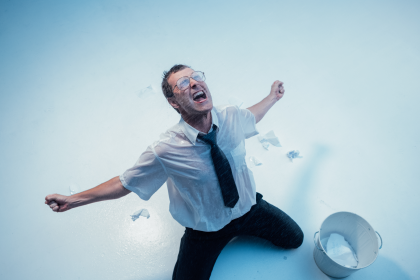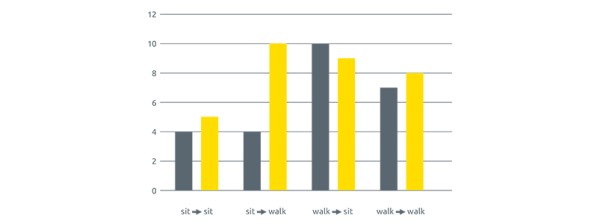Our solutions
Back
Mental movement
Psychosocial and physical strain during work is difficult to measure, but it is clear that a moment of physical and mental disconnection from work is essential to regularly recharge our battery to be able to work concentrated, perform best and not just energetic get through the day, but also be able to end energetically.
A while away from work leads to higher average performance, more creativity, better concentration and more energy.
Playing the mind games
Introducing pit stops during fencing increases work speed and reduces errors (Van den Heuvel et al., 2003), (Hedge & Evans, 2001). When employees leave their workplace and walk during these pit stops, energy levels rise and employees look at problems differently when they return (Nathan & Thayer, 2012, p. 411). This leads to more creativity and better problem solving (Oppezzo & Schwartz, 2014).

In practice
Translated into practice, VDU workers can significantly improve their work performance by moving away from their workplace for three minutes every hour and taking a short walk. The graph below also shows a tension between productivity, effort and the time a task takes without taking breaks.
Since starting a task takes a lot of effort to increase productivity, the graph shows that to be in a state of flow with as little effort as possible is very important to close concentration leaks and ensure that you are not interrupted when deep concentration is required.
It also shows that over time, productivity begins to decline and the effort required to complete the task increases. Taking pit stops at the right time helps to improve performance by avoiding loss of energy, efficiency and time.
Since starting a task takes a lot of effort to increase productivity, the graph shows that to be in a state of flow with as little effort as possible is very important to close concentration leaks and ensure that you are not interrupted when deep concentration is required.
It also shows that over time, productivity begins to decline and the effort required to complete the task increases. Taking pit stops at the right time helps to improve performance by avoiding loss of energy, efficiency and time.
Tired of not being able to make a well-considered decision
Study of Danziger
In a landmark study (Danziger et al., 2011), Danziger and colleagues examined factors that influence judges' early release decisions (Figure 1). The seriousness of the offense, the type of offense, the lawyer, and the prison all had no influence. However, there was one factor that influenced and was not influenced by the other factors: fatigue.
At the start of the day, the judges released 65% of the prisoners, after more than two hours it was 0%. After a moment of recovery it was again 65% and after that the percentage dropped rapidly. A second recovery resulted in 65% paroles, followed by a rapid decline. The explanation was that judges were no longer able to make informed decisions because of their fatigue. They unconsciously chose not to consider the possible consequences and leave the situation as it was; no early release.
With WORK & MOVE you really get moving!
At the start of the day, the judges released 65% of the prisoners, after more than two hours it was 0%. After a moment of recovery it was again 65% and after that the percentage dropped rapidly. A second recovery resulted in 65% paroles, followed by a rapid decline. The explanation was that judges were no longer able to make informed decisions because of their fatigue. They unconsciously chose not to consider the possible consequences and leave the situation as it was; no early release.
Need help? We're here for you
Look at our FAQ or contact us
Many customers preceded you
Read about their experience with BakkerElkhuizen
Select your country and language


